From Technology to Strategy: The Evolving Role of Smart Grids and Microgrids in Sustainable Energy Management
Abstract
1. Introduction
2. Literature Review
3. Research Methodology
3.1. Data Collection
3.2. Data Screening and Processing
3.3. Analytical Tools and Techniques
3.4. Temporal Segmentation
4. Results and Discussions
4.1. Publication Trends and Growth Patterns
4.2. Subject Categories
4.3. Leading Journals
4.4. Mapping the Contributions to the Sustainable Development Goals (SDGs)
4.5. Country-Level Contributions
4.6. Thematic Clustering
4.7. Overlay Visualization
4.8. Citation Trend Analysis (2009–2025)
5. Conclusions
Author Contributions
Funding
Data Availability Statement
Conflicts of Interest
References
- Hoang, A.T.; Nižetić, S.; Olcer, A.I.; Ong, H.C.; Chen, W.-H.; Chong, C.T.; Thomas, S.; Bandh, S.A.; Nguyen, X.P. Impacts of COVID-19 pandemic on the global energy system and the shift progress to renewable energy: Opportunities, challenges, and policy implications. Energy Policy 2021, 154, 112322. [Google Scholar] [CrossRef]
- Ibekwe, K.I.; Ohenhen, P.E.; Chidolue, O.; Umoh, A.A.; Ngozichukwu, B.; Ilojianya, V.I.; Fafure, A.V. Microgrid systems in US energy infrastructure: A comprehensive review: Exploring decentralized energy solutions, their benefits, and challenges in regional implementation. World J. Adv. Res. Rev. 2024, 21, 973–987. [Google Scholar] [CrossRef]
- Aguero, J.R.; Takayesu, E.; Novosel, D.; Masiello, R. Modernizing the grid: Challenges and opportunities for a sustainable future. IEEE Power Energy Mag. 2017, 15, 74–83. [Google Scholar] [CrossRef]
- Moreno Escobar, J.J.; Morales Matamoros, O.; Tejeida Padilla, R.; Lina Reyes, I.; Quintana Espinosa, H. A comprehensive review on smart grids: Challenges and opportunities. Sensors 2021, 21, 6978. [Google Scholar] [CrossRef] [PubMed]
- Aoun, A.; Ghandour, M.; Ilinca, A.; Ibrahim, H. Demand-side management. In Hybrid Renewable Energy Systems and Microgrids; Elsevier: Amsterdam, The Netherlands, 2021; pp. 463–490. [Google Scholar]
- Kostenko, G.; Zaporozhets, A. Enhancing of the power system resilience through the application of micro power systems (microgrid) with renewable distributed generation. Syst. Res. Energy 2023, 2023, 25–38. [Google Scholar] [CrossRef]
- Cavus, M. Advancing Power Systems with Renewable Energy and Intelligent Technologies: A Comprehensive Review on Grid Transformation and Integration. Electronics 2025, 14, 1159. [Google Scholar] [CrossRef]
- Yoldaş, Y.; Önen, A.; Muyeen, S.; Vasilakos, A.V.; Alan, I. Enhancing smart grid with microgrids: Challenges and opportunities. Renew. Sustain. Energy Rev. 2017, 72, 205–214. [Google Scholar] [CrossRef]
- Koliba, C.; DeMenno, M.; Brune, N.; Zia, A. The salience and complexity of building, regulating, and governing the smart grid: Lessons from a statewide public–private partnership. Energy Policy 2014, 74, 243–252. [Google Scholar] [CrossRef]
- Ahmad, N.; Ghadi, Y.G.; Adnan, M.; Ali, M. From smart grids to super smart grids: A roadmap for strategic demand management for next generation SAARC and European power infrastructure. IEEE Access 2023, 11, 12303–12341. [Google Scholar] [CrossRef]
- Kiasari, M.; Ghaffari, M.; Aly, H.H. A comprehensive review of the current status of smart grid technologies for renewable energies integration and future trends: The role of machine learning and energy storage systems. Energies 2024, 17, 4128. [Google Scholar] [CrossRef]
- Arévalo, P.; Jurado, F. Impact of artificial intelligence on the planning and operation of distributed energy systems in smart grids. Energies 2024, 17, 4501. [Google Scholar] [CrossRef]
- Hilmy, A.; HE, B.E. Next-Generation Smart Inverters: Bridging AI, Cybersecurity, and Policy Gaps for Sustainable Energy Transition. Technologies 2025, 13, 136. [Google Scholar] [CrossRef]
- Donthu, N.; Kumar, S.; Mukherjee, D.; Pandey, N.; Lim, W.M. How to conduct a bibliometric analysis: An overview and guidelines. J. Bus. Res. 2021, 133, 285–296. [Google Scholar] [CrossRef]
- Öztürk, O.; Kocaman, R.; Kanbach, D.K. How to design bibliometric research: An overview and a framework proposal. Rev. Manag. Sci. 2024, 18, 3333–3361. [Google Scholar] [CrossRef]
- Zupic, I.; Čater, T. Bibliometric methods in management and organization. Organ. Res. Methods 2015, 18, 429–472. [Google Scholar] [CrossRef]
- Arruda, H.; Silva, E.R.; Lessa, M.; Proença Jr, D.; Bartholo, R. VOSviewer and bibliometrix. J. Med. Libr. Assoc. JMLA 2022, 110, 392. [Google Scholar] [CrossRef]
- Zibaeirad, A.; Koleini, F.; Bi, S.; Hou, T.; Wang, T. A comprehensive survey on the security of smart grid: Challenges, mitigations, and future research opportunities. arXiv 2024, arXiv:2407.07966. [Google Scholar] [CrossRef]
- Corbett, L.W.; Weber, C.; Anderson, T. The Democratization of Energy though Neighborhood Microgrids. In Proceedings of the 2022 Portland International Conference on Management of Engineering and Technology (PICMET), IEEE, Portland, OR, USA, 7–11 August 2022. [Google Scholar]
- Khan, M.R.; Haider, Z.M.; Malik, F.H.; Almasoudi, F.M.; Alatawi, K.S.S.; Bhutta, M.S. A comprehensive review of microgrid energy management strategies considering electric vehicles, energy storage systems, and AI techniques. Processes 2024, 12, 270. [Google Scholar] [CrossRef]
- Kumar, N.M.; Chand, A.A.; Malvoni, M.; Prasad, K.A.; Mamun, K.A.; Islam, F.; Chopra, S.S. Distributed energy resources and the application of AI, IoT, and blockchain in smart grids. Energies 2020, 13, 5739. [Google Scholar] [CrossRef]
- Biswas, P.; Rashid, A.; Al Masum, A.; Al Nasim, M.A.; Ferdous, A.A.; Gupta, K.D.; Biswas, A. An extensive and methodical review of smart grids for sustainable energy management-addressing challenges with ai, renewable energy integration and leading-edge technologies. IEEE Access 2025, 1. [Google Scholar] [CrossRef]
- Trivedi, R.; Patra, S.; Sidqi, Y.; Bowler, B.; Zimmermann, F.; Deconinck, G.; Papaemmanouil, A.; Khadem, S. Community-based microgrids: Literature review and pathways to decarbonise the local electricity network. Energies 2022, 15, 918. [Google Scholar] [CrossRef]
- Teladia, A.; van der Windt, H. Lights, Policy, Action: A Multi-Level Perspective on Policy Instrument Mix Interactions for Community Energy Initiatives. Energies 2025, 18, 2823. [Google Scholar] [CrossRef]
- Pavon, W.; Inga, E.; Simani, S.; Nonato, M. A review on optimal control for the smart grid electrical substation enhancing transition stability. Energies 2021, 14, 8451. [Google Scholar] [CrossRef]
- Younesi, A.; Shayeghi, H.; Safari, A.; Siano, P. Assessing the resilience of multi microgrid based widespread power systems against natural disasters using Monte Carlo Simulation. Energy 2020, 207, 118220. [Google Scholar] [CrossRef]
- Ali, S.; Rehman, A.U.; Wadud, Z.; Khan, I.; Murawwat, S.; Hafeez, G.; Albogamy, F.R.; Khan, S.; Samuel, O. Demand response program for efficient demand-side management in smart grid considering renewable energy sources. IEEE Access 2022, 10, 53832–53853. [Google Scholar] [CrossRef]
- Munir, M.S.; Shetty, S.; Rawat, D.B. Trustworthy artificial intelligence framework for proactive detection and risk explanation of cyber attacks in smart grid. In Proceedings of the 2023 Winter Simulation Conference (WSC), San Antonio, TX, USA, 10–13 December 2023. [Google Scholar]
- Mahdi, B.S.; Sulaiman, N.; Abd Shehab, M.; Shafie, S.; Hizam, H.; Hassan, S.L.B.M. Optimization of operating cost and energy consumption in a smart grid. IEEE Access 2024, 12, 18837–18850. [Google Scholar] [CrossRef]
- Bodewes, W.; de Hoog, J.; Ratnam, E.L.; Halgamuge, S. Exploring the intersection of artificial intelligence and microgrids in developing Economies: A review of Practical applications. Curr. Sustain. Renew. Energy Rep. 2024, 11, 10–23. [Google Scholar] [CrossRef]
- He, J.-H.; Lin, J.-H. Review of Microgrids to Enhance Power System Resilience. Eng. Proc. 2025, 92, 82. [Google Scholar]
- AT, M.R.; RR, S.A.P.; Naidu, R.C.; Ramachandran, P.; Rajkumar, S.; Kumar, V.N.; Aggarwal, G.; Siddiqui, A.M. Intelligent Energy Management across Smart Grids Deploying 6G IoT, AI, and Blockchain in Sustainable Smart Cities. IoT 2024, 5, 560–591. [Google Scholar] [CrossRef]
- Liang, Z.; Chung, C.Y.; Zhang, W.; Wang, Q.; Lin, W.; Wang, C. Enabling high-efficiency economic dispatch of hybrid AC/DC networked microgrids: Steady-state convex bi-directional converter models. IEEE Trans. Smart Grid 2024, 16, 45–61. [Google Scholar] [CrossRef]
- Elazab, R.; Dahab, A.A.; Adma, M.A.; Hassan, H.A. Reviewing the frontier: Modeling and energy management strategies for sustainable 100% renewable microgrids. Discov. Appl. Sci. 2024, 6, 168. [Google Scholar] [CrossRef]
- Sarwar, F.A.; Hernando-Gil, I.; Vechiu, I. Review of energy management systems and optimization methods for hydrogen-based hybrid building microgrids. Energy Convers. Econ. 2024, 5, 259–279. [Google Scholar] [CrossRef]
- Judge, M.A.; Franzitta, V.; Curto, D.; Guercio, A.; Cirrincione, G.; Khattak, H.A. A comprehensive review of artificial intelligence approaches for smart grid integration and optimization. Energy Convers. Manag. X 2024, 24, 100724. [Google Scholar] [CrossRef]
- Klarin, A. How to conduct a bibliometric content analysis: Guidelines and contributions of content co-occurrence or co-word literature reviews. Int. J. Consum. Stud. 2024, 48, e13031. [Google Scholar] [CrossRef]
- Diaconescu, M.; Marinas, L.E.; Marinoiu, A.M.; Popescu, M.-F.; Diaconescu, M.J. Towards renewable energy transition: Insights from bibliometric analysis on scholar discourse to policy actions. Energies 2024, 17, 4719. [Google Scholar] [CrossRef]
- Zhou, Y.; Pan, J. Analysis of the process and outcomes of the first Global Stocktake under the Paris Agreement. Chin. J. Popul. Resour. Environ. 2025, 23, 143–152. [Google Scholar] [CrossRef]
- Lescrauwaet, L.; Wagner, H.; Yoon, C.; Shukla, S. Adaptive legal frameworks and economic dynamics in emerging tech-nologies: Navigating the intersection for responsible innovation. Law Econ. 2022, 16, 202–220. [Google Scholar] [CrossRef]
- Nguyen, K.H.; Tran, M.D.; Duong, T.T.-T. Global Knowledge Networks on Circular Economy and Sustainable Consumption: Sociological Insights into Emerging Environmental Discourses. Circ. Econ. Sustain. 2025, 1–30. [Google Scholar] [CrossRef]
- Wang, Z.; Liu, Y.; Ma, Z.; Liu, X.; Ma, J. LiPSG: Lightweight privacy-preserving Q-learning-based energy management for the IoT-enabled smart grid. IEEE Internet Things J. 2020, 7, 3935–3947. [Google Scholar] [CrossRef]
- Vision, S. Kingdom of Saudi Arabia Vision 2030. 2022. Available online: https://vision2030.gov.sa/en (accessed on 27 August 2025).
- Bank, W. Morocco: Noor Solar Complex. 2022. Available online: https://www.worldbank.org/en/news/feature/2022/11/04/morocco-noor-solar-complex (accessed on 27 August 2025).
- She, B.; Li, F.; Cui, H.; Zhang, J.; Bo, R. Fusion of Model-free Reinforcement Learning with Microgrid Control: Review and Vision. arXiv 2022, arXiv:2206.11398. [Google Scholar] [CrossRef]
- Gharavi, H.; Ghafurian, R. Smart Grid: The Electric Energy System of the Future; IEEE: Piscataway, NJ, USA, 2011; Volume 99. [Google Scholar]
- Azevedo, S.G.; Santos, M.; Antón, J.R. Supply chain of renewable energy: A bibliometric review approach. Biomass Bioenergy 2019, 126, 70–83. [Google Scholar] [CrossRef]
- Parag, Y.; Sovacool, B.K. Electricity market design for the prosumer era. Nat. Energy 2016, 1, 16032. [Google Scholar] [CrossRef]
- Guerrero, J.M.; Vasquez, J.C.; Matas, J.; De Vicuña, L.G.; Castilla, M. Hierarchical control of droop-controlled AC and DC microgrids—A general approach toward standardization. IEEE Trans. Ind. Electron. 2010, 58, 158–172. [Google Scholar] [CrossRef]
- Khan, A.; Bressel, M.; Davigny, A.; Abbes, D.; Ould Bouamama, B. Comprehensive Review of Hybrid Energy Systems: Challenges, Applications, and Optimization Strategies. Energies 2025, 18, 2612. [Google Scholar] [CrossRef]
- Juma, S.A.; Ayeng’o, S.P.; Kimambo, C.Z. A review of control strategies for optimized microgrid operations. IET Renew. Power Gener. 2024, 18, 2785–2818. [Google Scholar] [CrossRef]
- Manias, D.M.; Saber, A.M.; Radaideh, M.I.; Gaber, A.T.; Maniatakos, M.; Zeineldin, H.; Svetinovic, D.; El-Saadany, E.F. Trends in smart grid cyber-physical security: Components, threats and solutions. IEEE Access 2024, 12, 161329–161356. [Google Scholar] [CrossRef]
- González-Niño, M.E.; Sierra-Herrera, O.H.; Pineda-Muñoz, W.A.; Muñoz-Galeano, N.; López-Lezama, J.M. Exploring Technology Trends and Future Directions for Optimized Energy Management in Microgrids. Information 2025, 16, 183. [Google Scholar] [CrossRef]
- Esparza, A.; Blondin, M.; Trovão, J.P.F. A Review of Optimization Strategies for Energy Management in Microgrids. Energies 2025, 18, 3245. [Google Scholar] [CrossRef]
- Chou, C.-H.; Ngo, S.L.; Tran, P.P. Renewable energy integration for sustainable economic growth: Insights and challenges via bibliometric analysis. Sustainability 2023, 15, 15030. [Google Scholar] [CrossRef]
- Liu, Y.-Z.; Lu, W.-M.; Tran, P.P.; Pham, T.A.K. Sustainable energy and semiconductors: A bibliometric investigation. Sustainability 2024, 16, 6548. [Google Scholar] [CrossRef]
- Ehnberg, J.; Cardarelli, P.; Hultén, L.; Shaikh, M.M.; Sivakumar, G.; Vishwanatha, R. Short and Long term Smart grid Contribution to the Sustainable Development Goals. In Proceedings of the 2021 IEEE Southern Power Electronics Conference (SPEC), Virtual, 6–9 December 2021. [Google Scholar]
- Almihat, M.G.M.; Munda, J.L. The Role of Smart Grid Technologies in Urban and Sustainable Energy Planning. Energies 2025, 18, 1618. [Google Scholar] [CrossRef]
- Zepter, J.M.; Lüth, A.; Del Granado, P.C.; Egging, R. Prosumer integration in wholesale electricity markets: Synergies of peer-to-peer trade and residential storage. Energy Build. 2019, 184, 163–176. [Google Scholar] [CrossRef]
- Faia, R.; Soares, J.; Pinto, T.; Lezama, F.; Vale, Z.; Corchado, J.M. Optimal model for local energy community scheduling considering peer to peer electricity transactions. IEEE Access 2021, 9, 12420–12430. [Google Scholar] [CrossRef]
- Hardy, J.; Mazur, C. Enabling conditions for consumer-centric business models in the united kingdom energy market. Front. Energy Res. 2020, 8, 528415. [Google Scholar] [CrossRef]
- Roslan, M.; Hannan, M.; Ker, P.J.; Uddin, M. Microgrid control methods toward achieving sustainable energy management. Appl. Energy 2019, 240, 583–607. [Google Scholar] [CrossRef]
- Solanki, B.V.; Bhattacharya, K.; Canizares, C.A. A sustainable energy management system for isolated microgrids. IEEE Trans. Sustain. Energy 2017, 8, 1507–1517. [Google Scholar] [CrossRef]
- Tajjour, S.; Chandel, S.S.; Chandel, R.; Thakur, N. Power generation enhancement analysis of a 400 kWp grid-connected rooftop photovoltaic power plant in a hilly terrain of India. Energy Sustain. Dev. 2023, 77, 101333. [Google Scholar] [CrossRef]
- Sifat, M.M.H.; Choudhury, S.M.; Das, S.K.; Ahamed, M.H.; Muyeen, S.; Hasan, M.M.; Ali, M.F.; Tasneem, Z.; Islam, M.M.; Islam, M.R. Towards electric digital twin grid: Technology and framework review. Energy AI 2023, 11, 100213. [Google Scholar] [CrossRef]
- Tsegaye, S.; Heyi, K.G.; Endaylalu, M.T.; Melaku, Z.A.; Turufi, K.T. Deep Neural Networks in Smart Grid Digital Twins: Evolution, Challenges, and Future Outlooks. IEEE Access 2025, 13, 114845–114864. [Google Scholar] [CrossRef]
- Ray, P.; Ray, P.K.; Dash, S.K. Power quality enhancement and power flow analysis of a PV integrated UPQC system in a distribution network. IEEE Trans. Ind. Appl. 2021, 58, 201–211. [Google Scholar] [CrossRef]
- Hannan, M.; Abdolrasol, M.G.; Faisal, M.; Ker, P.J.; Begum, R.; Hussain, A. Binary particle swarm optimization for scheduling MG integrated virtual power plant toward energy saving. IEEE Access 2019, 7, 107937–107951. [Google Scholar] [CrossRef]
- Nilsson, A.; Lazarevic, D.; Brandt, N.; Kordas, O. Household responsiveness to residential demand response strate-gies: Results and policy implications from a Swedish field study. Energy Policy 2018, 122, 273–286. [Google Scholar] [CrossRef]
- Hansen, P.; Liu, X.; Morrison, G.M. Agent-based modelling and socio-technical energy transitions: A systematic literature review. Energy Res. Social Sci. 2019, 49, 41–52. [Google Scholar] [CrossRef]
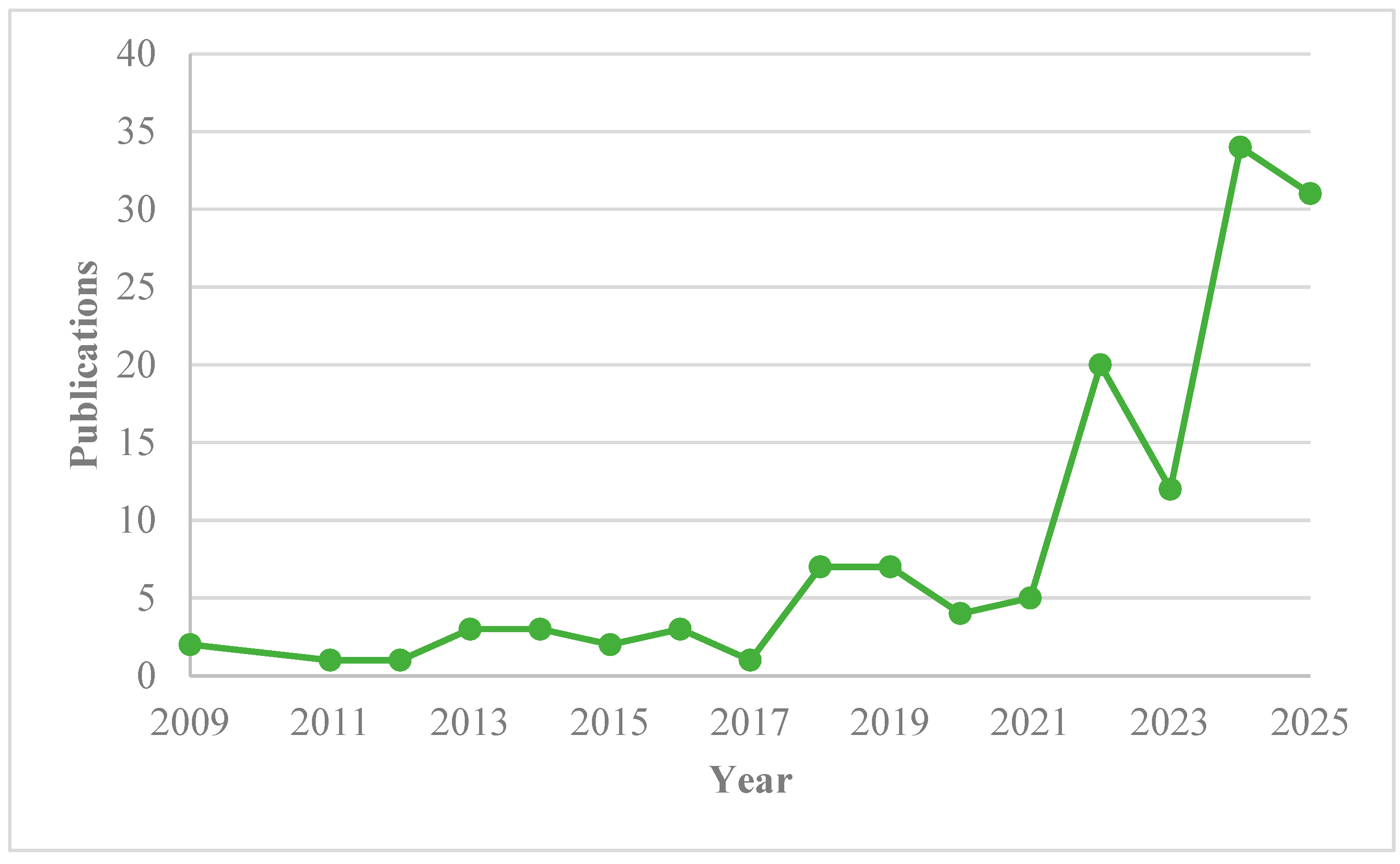
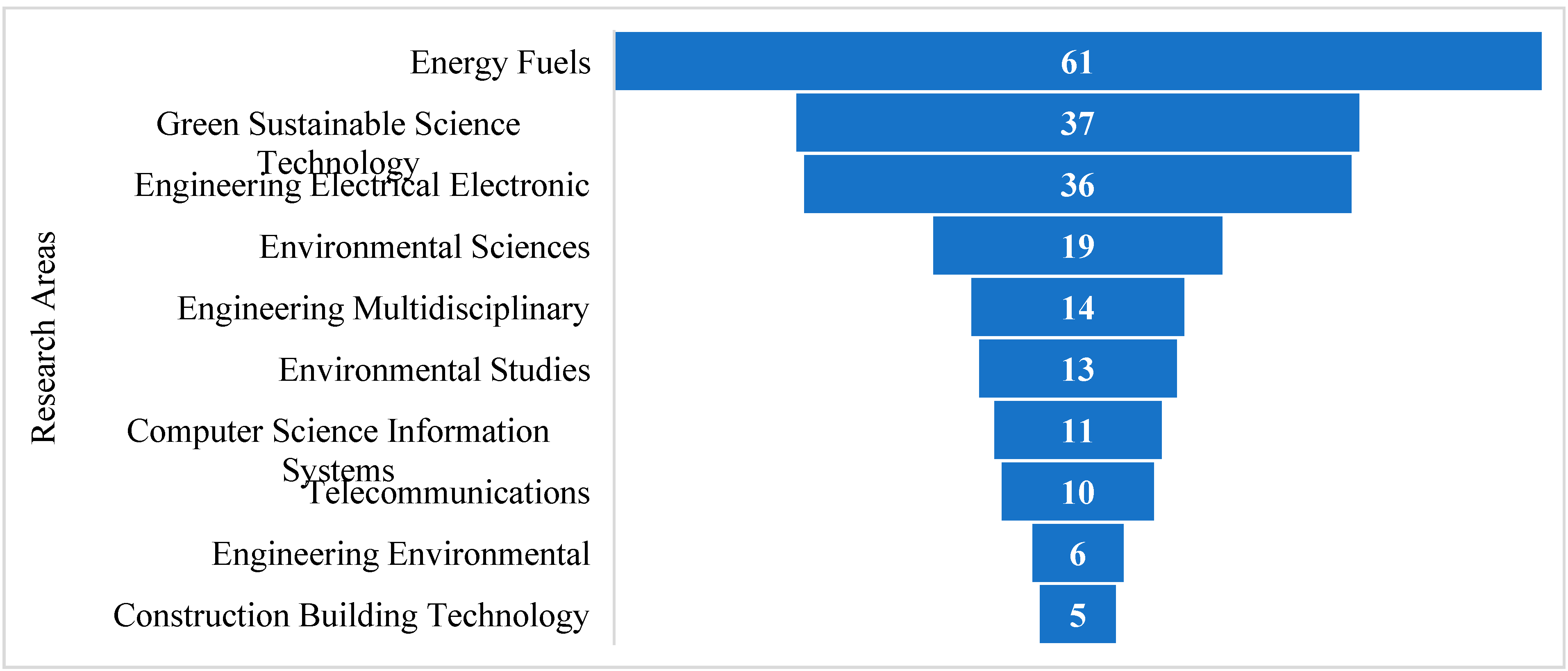
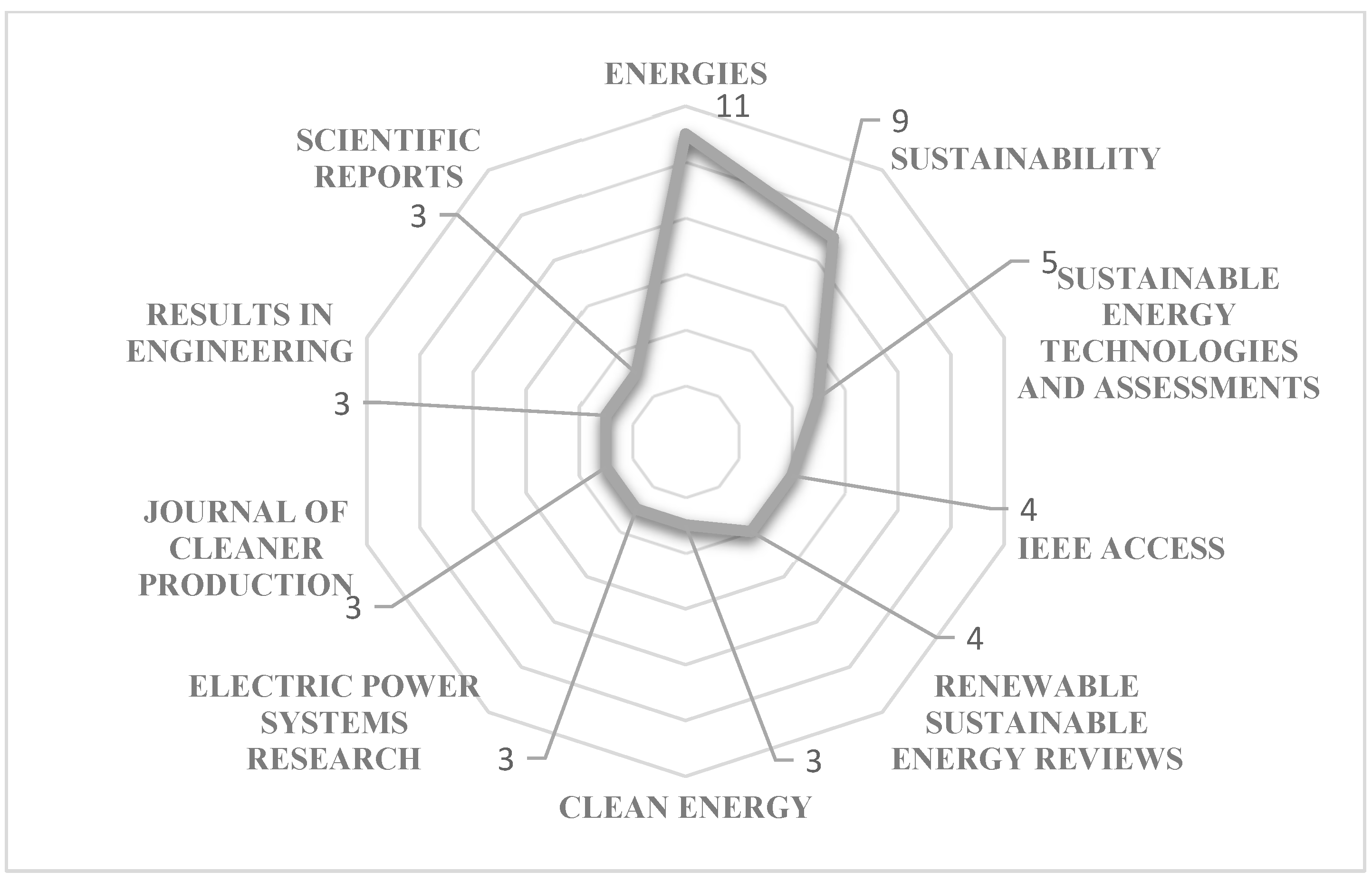
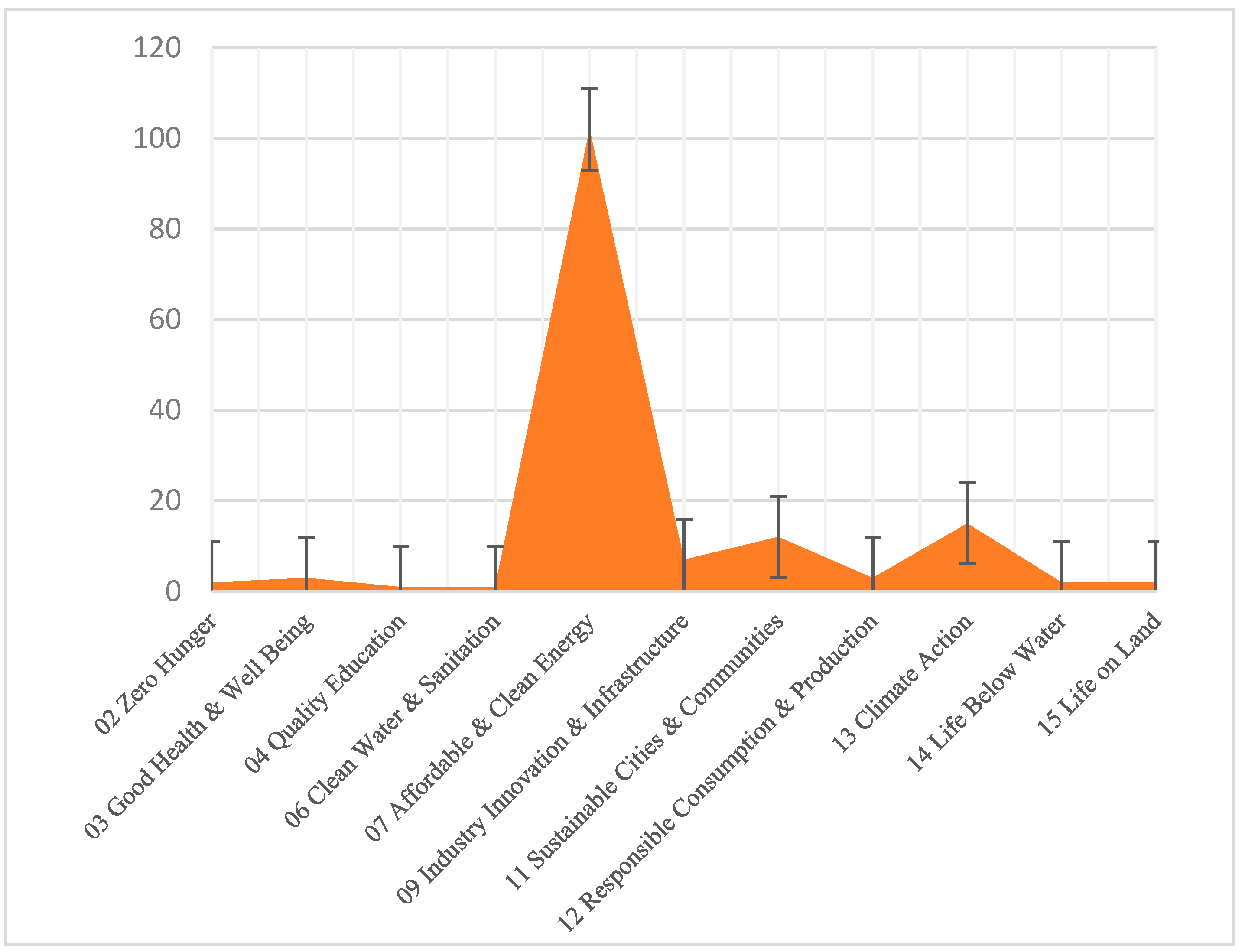
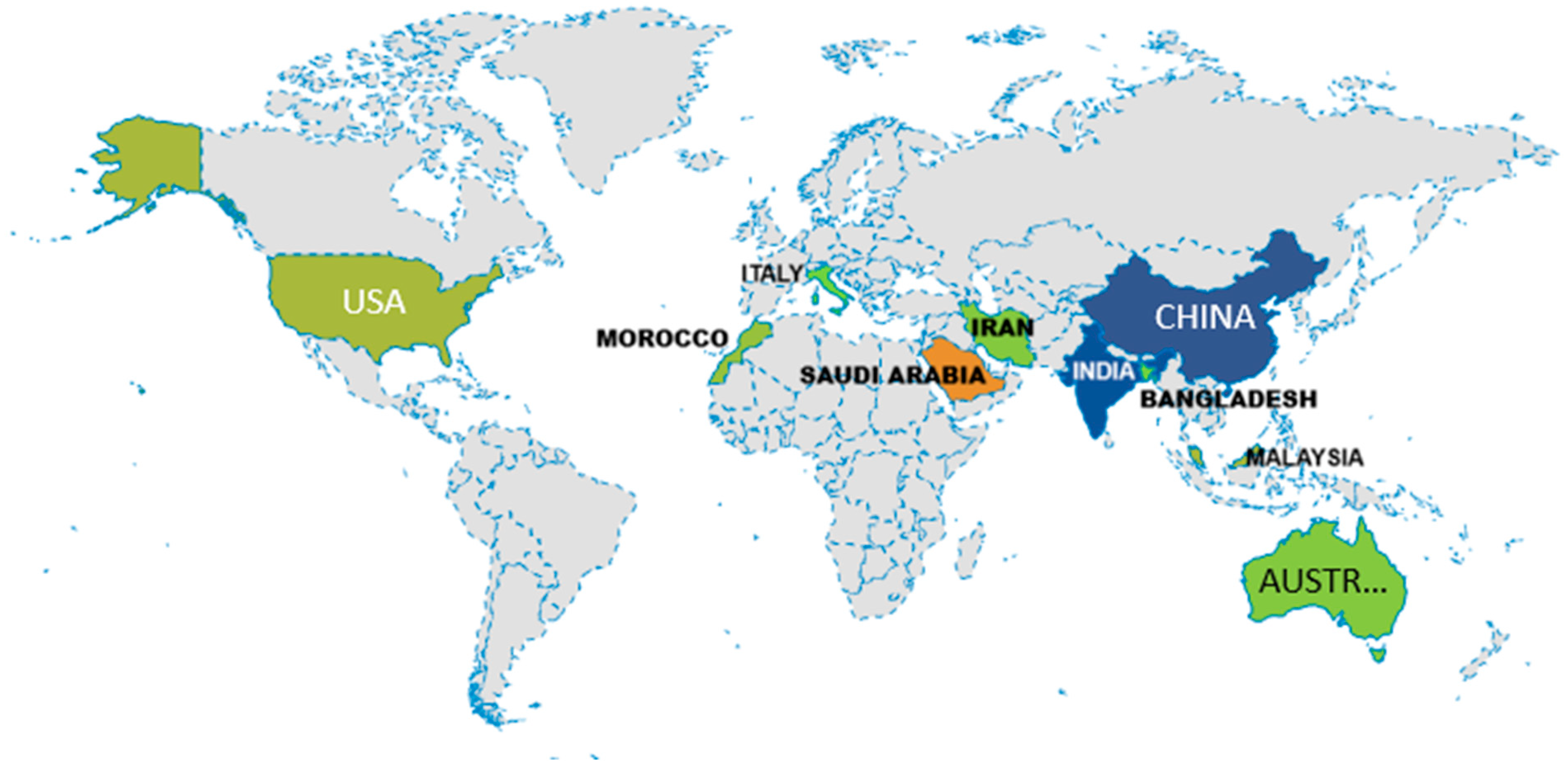
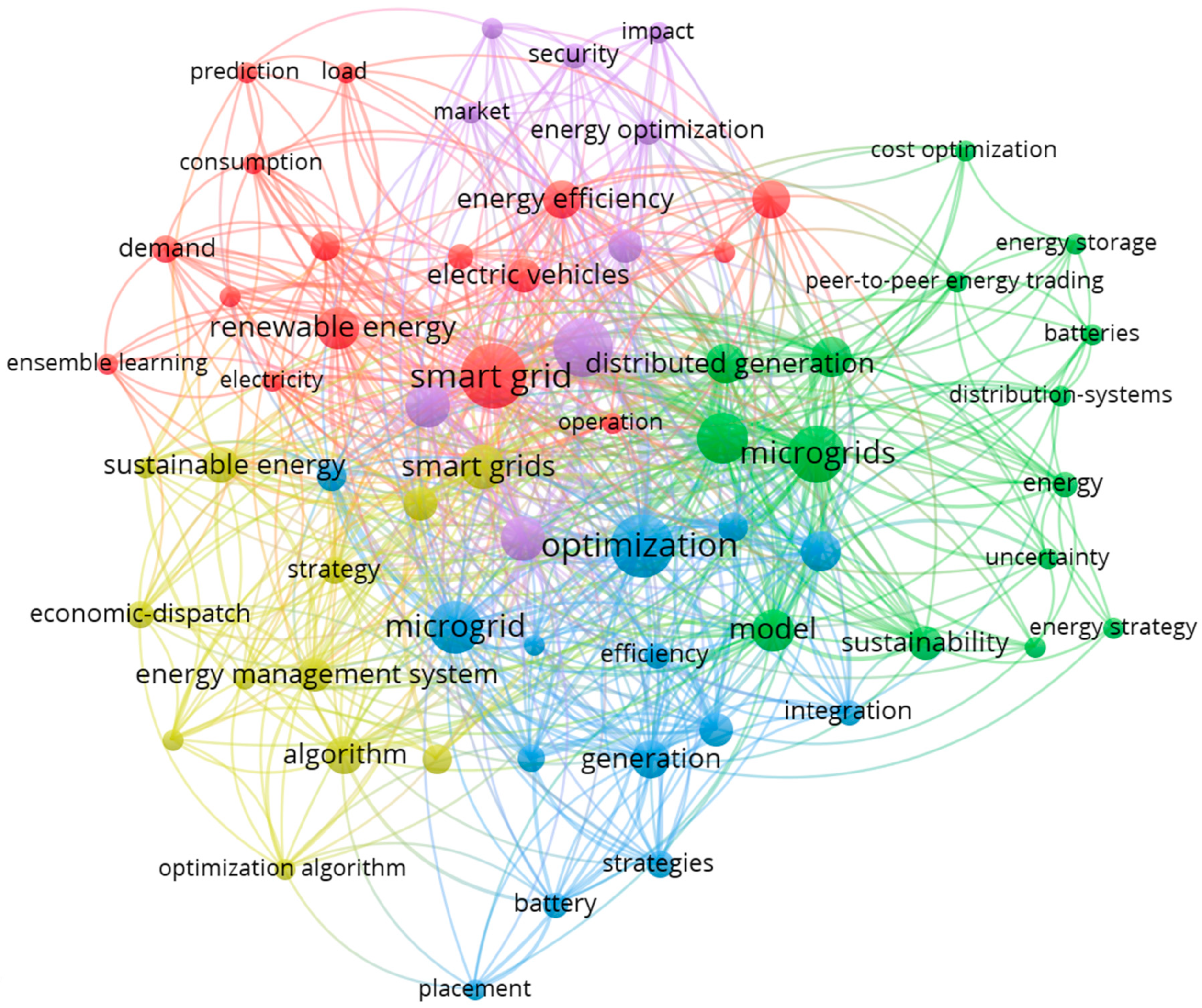
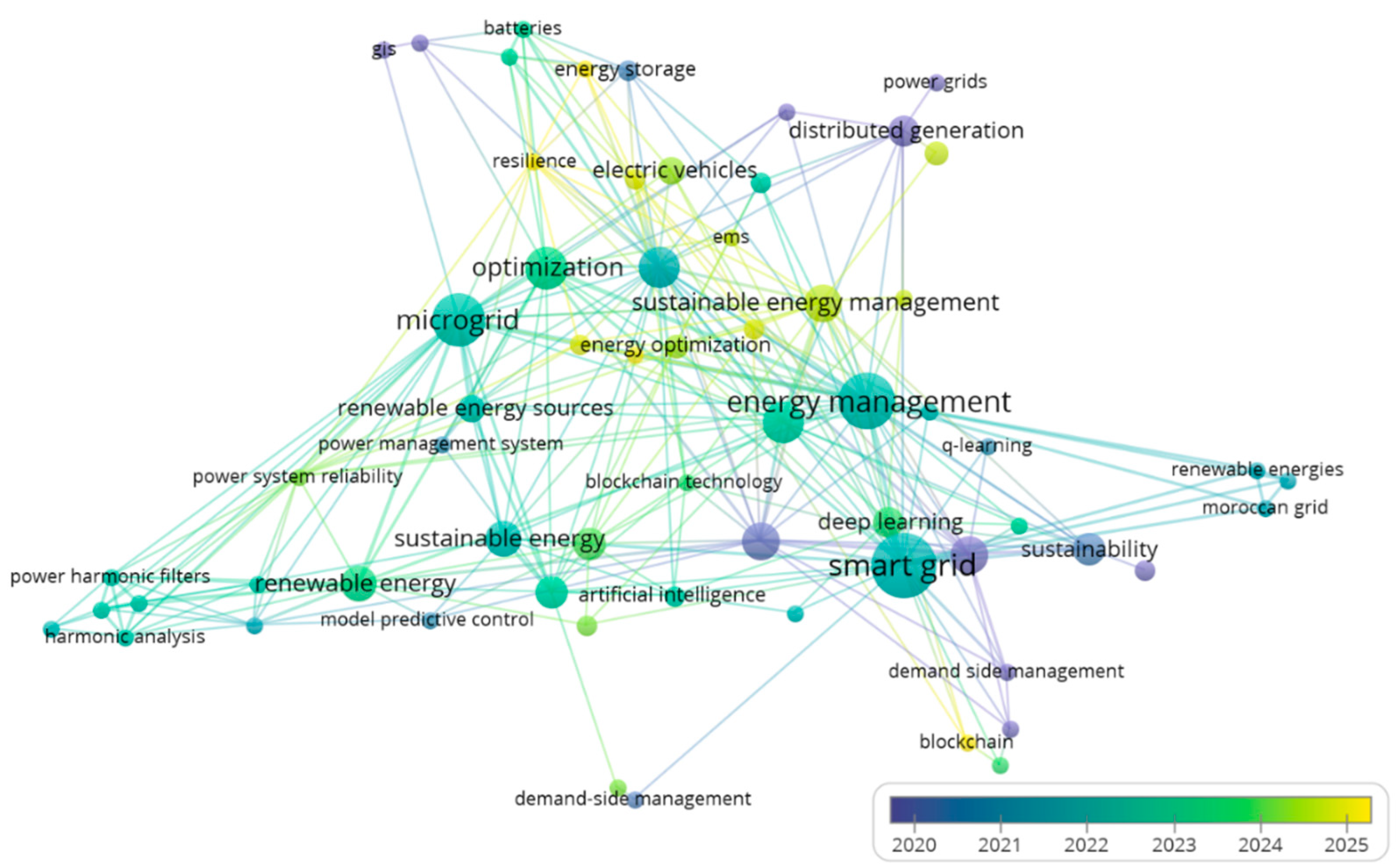
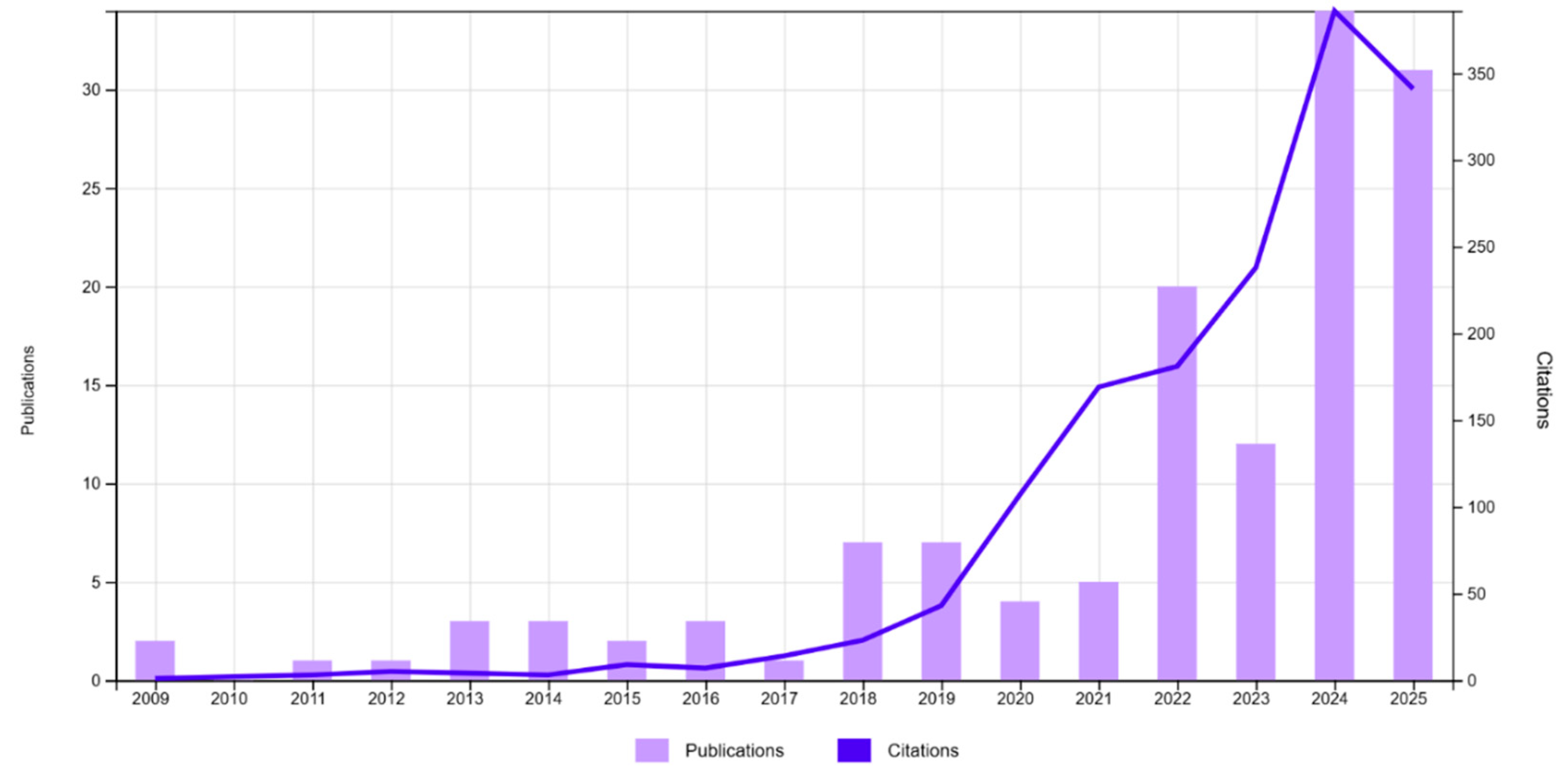
| Cluster | Focus Area | Keywords (Selected) | Key Themes |
|---|---|---|---|
| Red | Renewable Energy and Smart Grid | Renewable energy, electric vehicles, energy efficiency | Integration and load management |
| Green | Microgrids and Distributed Energy Systems | Microgrids, energy storage, peer-to-peer, trading | Decentralization and resilience |
| Blue | Optimization Models and Techniques | Optimization, model, generation, placement | Modeling and simulation |
| Yellow | Control Systems and Algorithms | EMS, economic dispatch, algorithm, strategy | Control strategies and energy balance |
| Purple | Cybersecurity and System Resilience | Security, impact, smart grids, operation | Safety, reliability, digital risk |
| Period | Color | Prominent Keywords | Research Focus |
|---|---|---|---|
| 2020–2021 | Dark Blue/Purple | Smart grid, Deep learning, Blockchain, Sustainability | Foundational technologies and early integration of AI and digital tools in energy systems |
| 2022–2023 | Green | Energy management, Renewable energy, Sustainable energy, Microgrid | Application-oriented research, energy distribution optimization, and integration of renewables |
| 2024–2025 | Yellow | Optimization, Energy storage, Electric vehicles, Resilience, Artificial intelligence | Emerging trends focused on intelligent systems, sustainability, resilience, and electric mobility. |
| Title | First Authors | Source Title | Year | Total Citations | Average per Year |
|---|---|---|---|---|---|
| Prosumer integration in wholesale electricity markets: synergies of peer-to-peer trade residential storage | Zepter, Jan Martin | Energy and Buildings | 2019 | 173 | 24.71 |
| Microgrid control methods toward achieving sustainable energy management | Roslan, M. F. | Applied Energy | 2019 | 94 | 13.43 |
| A Sustainable Energy Management System for Isolated Microgrids | Solanki, Bharatkumar V. | IEEE Transactions on Sustainable Energy | 2017 | 90 | 10 |
| Power Quality Enhancement and Power Flow Analysis of a PV Integrated UPQC System in a Distribution Network | Ray, Pragnyashree | IEEE Transactions on Industry Applications | 2022 | 69 | 17.25 |
| Towards electric digital twin grid: Technology and framework review | Sifat, Md. Mhamud Hussen | Energy and AI | 2023 | 68 | 17 |
| Optimal Model for Local Energy Community Scheduling Considering Peer to Peer Electricity Transactions | Faia, Ricardo | IEEE Access | 2021 | 67 | 13.4 |
| A comprehensive review on sustainable energy management systems for optimal operation of future-generation of solar microgrids | Tajjour, Salwan | Sustainable Energy Technologies and Assessments | 2023 | 53 | 17.67 |
| LiPSG: Lightweight Privacy-Preserving Q-Learning-Based Energy Management for the IoT-Enabled Smart Grid | Wang, Zhuzhu | IEEE Internet of Things Journal | 2020 | 48 | 8 |
| Binary Particle Swarm optimization for Scheduling MG Integrated Virtual Power Plant Toward Energy Saving | Hannan, M. A | IEEE Access | 2019 | 46 | 6.57 |
| Household responsiveness to residential demand response strategies: Results and policy implications from a Swedish field study | Nilsson, Anders | Energy Policy | 2018 | 45 | 5.63 |
Disclaimer/Publisher’s Note: The statements, opinions and data contained in all publications are solely those of the individual author(s) and contributor(s) and not of MDPI and/or the editor(s). MDPI and/or the editor(s) disclaim responsibility for any injury to people or property resulting from any ideas, methods, instructions or products referred to in the content. |
© 2025 by the authors. Licensee MDPI, Basel, Switzerland. This article is an open access article distributed under the terms and conditions of the Creative Commons Attribution (CC BY) license (https://creativecommons.org/licenses/by/4.0/).
Share and Cite
Lu, W.-M.; Le, T.-T. From Technology to Strategy: The Evolving Role of Smart Grids and Microgrids in Sustainable Energy Management. Energies 2025, 18, 4609. https://doi.org/10.3390/en18174609
Lu W-M, Le T-T. From Technology to Strategy: The Evolving Role of Smart Grids and Microgrids in Sustainable Energy Management. Energies. 2025; 18(17):4609. https://doi.org/10.3390/en18174609
Chicago/Turabian StyleLu, Wen-Min, and Thu-Thao Le. 2025. "From Technology to Strategy: The Evolving Role of Smart Grids and Microgrids in Sustainable Energy Management" Energies 18, no. 17: 4609. https://doi.org/10.3390/en18174609
APA StyleLu, W.-M., & Le, T.-T. (2025). From Technology to Strategy: The Evolving Role of Smart Grids and Microgrids in Sustainable Energy Management. Energies, 18(17), 4609. https://doi.org/10.3390/en18174609






